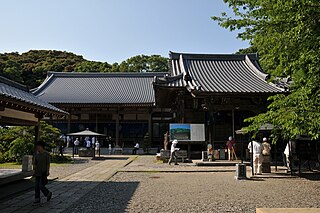 W
WBuddhist temples or Buddhist monasteries together with Shinto shrines, are considered to be amongst the most numerous, famous, and important religious buildings in Japan. The shogunates or leaders of Japan have made it a priority to update and rebuild Buddhist temples since the Momoyama period. The Japanese word for a Buddhist monastery is tera (寺) and the same kanji also has the pronunciation ji, so that temple names frequently end in -dera or -ji. Another ending, -in (院), is normally used to refer to minor temples. Such famous temples as Kiyomizu-dera, Enryaku-ji and Kōtoku-in are temples which use the described naming pattern.
 W
WIn Japan, a chinjusha is a Shinto shrine which enshrines a tutelary kami ; that is, a patron spirit that protects a given area, village, building or a Buddhist temple. The Imperial Palace has its own tutelary shrine dedicated to the 21 guardian gods of Ise Shrine. Tutelary shrines are usually very small, but there is a range in size, and the great Hiyoshi Taisha for example is Enryaku-ji's tutelary shrine. The tutelary shrine of a temple or the complex the two together form are sometimes called a temple-shrine . If a tutelary shrine is called chinju-dō, it is the tutelary shrine of a Buddhist temple. Even in that case, however, the shrine retains its distinctive architecture.
 W
WIn Japanese a Benten-dō is a Buddhist temple dedicated to Benten or Benzaiten, goddess of wealth, happiness, wisdom and music. Many such temples exist all over Japan.
 W
WA bodaiji in Japanese Buddhism is a temple which, generation after generation, takes care of a family's dead, giving them burial and performing ceremonies in their soul's favor. The name is derived from the term bodai (菩提), which originally meant just Buddhist enlightenment (satori), but which in Japan has also come to mean either the care of one's dead to ensure their welfare after death or happiness in the beyond itself. Several samurai families including the Tokugawa had their bodaiji built to order, while others followed the example of commoners and simply adopted an existing temple as family temple. Families may have more than one bodaiji. The Tokugawa clan, for example, had two, while the Ashikaga clan had several, both in the Kantō and the Kansai areas.
 W
WUntil the Meiji period (1868–1912), the jingū-ji were places of worship composed of a Buddhist temple and a Shintō shrine, both dedicated to a local kami. These complexes were born when a temple was erected next to a shrine to help its kami with its karmic problems. At the time, kami were thought to be also subjected to karma, and therefore in need of a salvation only Buddhism could provide. Having first appeared during the Nara period (710–794), jingū-ji remained common for over a millennium until, with few exceptions, they were destroyed in compliance with the Kami and Buddhas Separation Act of 1868. Seiganto-ji is a Tendai temple part of the Kumano Sanzan Shinto shrine complex, and as such can be considered one of the few shrine-temples still extant.
 W
WKokutai-ji , originally Tosho-ji (東松寺), is one of fourteen autonomous branches of the Rinzai school of Japanese Zen, founded in 1300 by the monk Jiun Myoi in Toyama, Japan. In 1327 Emperor Go-Daigo gave the temple the name Kokutai-ji, and Jiun Myoi became Seisen Zenji.
 W
WMount Hiei is a mountain to the northeast of Kyoto, lying on the border between the Kyoto and Shiga Prefectures, Japan.
 W
WNaka-in is a Tendai Buddhist temple in Kawagoe City, Saitama Prefecture. Sangō is Seiyasan. Jigō is Muryoju-ji. Ingō is Naka-in.
 W
WThe term "National Treasure" has been used in Japan to denote cultural properties since 1897. The definition and the criteria have changed since the inception of the term. The temple structures in this list were designated national treasures when the Law for the Protection of Cultural Properties was implemented on June 9, 1951. The items are selected by the Ministry of Education, Culture, Sports, Science and Technology based on their "especially high historical or artistic value". This list presents 157 entries of national treasure temple structures from the late 7th-century Classical Asuka period to the early modern 19th-century Edo period. The number of structures listed is more than 157, because in some cases groups of related structures are combined to form a single entry. The structures include main halls such as kon-dō, hon-dō, Butsuden; pagodas, gates, belfries , corridors, other halls and structures that are part of a Buddhist temple.
 W
WKokubun-ji (国分寺) were Buddhist temples established in each of the provinces of Japan by Emperor Shōmu during the Nara period.
 W
WA sandō in Japanese architecture is the road approaching either a Shinto shrine or a Buddhist temple. Its point of origin is usually straddled in the first case by a Shinto torii, in the second by a Buddhist sanmon, gates which mark the beginning of the shrine's or temple territory. The word dō (道) can refer both to a path or road, and to the path of one's life's efforts. There can also be stone lanterns and other decorations at any point along its course.
 W
WSekkei-ji is a Shingon Buddhist Temple located in Kōchi, Kōchi, Japan. It is the 33rd temple of the Shikoku Pilgrimage.
 W
WShinshō-ji is a Shingon Buddhist Temple located in Muroto, Kōchi, Japan. It is the 25th temple of the Shikoku Pilgrimage.
 W
WShōryū-ji (青龍寺 kana: しょうりゅうじ) is a Shingon Buddhist Temple located in Tosa, Kōchi, Japan. It is the 36th temple of the Shikoku Pilgrimage.
 W
WTanema-ji is a Shingon Buddhist Temple located in Kōchi, Kōchi, Japan. It is the 34th temple of the Shikoku Pilgrimage.
 W
WZenjibu-ji is a Shingon Buddhist Temple located in Nankoku, Kōchi, Japan. It is the 32nd temple of the Shikoku Pilgrimage.